The Story That Never Gets Told
Published on January 13th, 2015
Stefan Lehnert from Germany acquired the Bill Tripp designed Turner 56 Passion 4 C in 2009, and has been campaigning her with success in the waters of New England /USA (Bermuda Race, Annapolis Newport Race, Marblehead-Halifax race) and in the Caribbean races of Sint Maarten, Antigua and Virgin Gorda.
While race stories often focus on the success of a few, here Matthew Reid shares Passion’s tale of struggle and survival as she endeavored to compete in the Boxing Day classic. It is the story that never gets told…
The 2014 Rolex Sydney Hobart Yacht Race certainly lived up to its reputation as one of the world’s toughest races this year. But in the end, after a huge New Year’s fireworks display and dock party, it was all worth it!
The whole story really starts November 8, 2013 in Newport Rhode Island, when we set sail in a nor’easterner down to Sint Maarten to be in the Caribbean for the owner’s Christmas holiday down island and then the Caribbean 600 on the 24th of February.
After the 600, which, I believe will continue to grow in popularity, I headed back to Sint Maarten from Antigua. I had the boat flipped over from racing to cruising for the Pacific crossing and took off with my first load of guests on March 8 – merely one week after getting back from the Caribbean 600. We headed for the BVI and a five day cruise for them.
We then jumped off for Panama and the canal. A wild crossing of the Caribbean Sea ensued with a mid-morning arrival in Colon and the Shelter Bay Marina. Subsequently, I transited the canal, went to Sydney via the Galapagos, Marquesas, Tuamotus, Society Islands, Tonga (Vava’u Group), Fiji, Vanuatu and New Caledonia.
I arrived from Noumea, New Caledonia at the Cruising Yacht Club of Australia on November 17, 2014. I had just spent one year, one week and two days on the yacht. Then began the frantic minor refit and race preparation. I immediately met the chief inspector for the race, where a list was made that was do-able (and expensive), but quite long to make the boat comply. Besides, we had a torn-out stanchion, dead generator, etc., no wind instruments, etc. (we lost system after system on the pacific crossing).
After a week, I got the boat to Noakes Shipyard and Sean Langdon and crew began the process of the minor refit. Rig out, total break-down, dye-test of rods, re-alignment of spreaders, re-built shivs, new instrument wires pulled, etc. The whole boom to gooseneck fittings were blown out and needed bushings and new pin. A new spectra outhaul line was run to the hydraulic ram in the boom as well.
On goes the bow-sprit, bottom paint, anodes, and all new running rigging. We spent quite some time re-running mast halyards since severe chafing on the kevlar sleeve that protects the light wires, VHF antenna cable and B&G wind instruments cable obviously was indicating crossed halyards.
I did a total service on both the main engine (belts, some hoses, fluids, filters, raw water impeller, etc.) and genset (genset was pulled out, new coolant pump ordered, new capacitors and voltage regulators ordered, new hoses, etc.), replaced kitchen faucets and a myriad of other things.
By now Alec Snyder had arrived (December 8) and things were really moving along. Shortly after, Tim Mueller arrived (December 11) and the three of us put our heads down and really pressed hard. The boat had to be totally empty of all things for the weighing and measuring, as well as all the rig work, race prep, etc. I also had the transom repainted due to minor ding.
We went through the weighing and measuring process and received our rating… and the yard bill. WOW. Thunderstorms had slowed the painting process, genset parts were slow to arrive, and the boat ended up being on the hard for 17 days, 10 days over schedule. Alec and I met with the PM and due to Alec’s acumen, we shaved over $5,000 off the bill. Cheers, brah!
Back in and over to the CYCA on the December 17, the next crew member arrived a couple days later, with the rest coming in on 22-23.
We still had a lot of issues to address in order to pass our safety inspection. The SSB radio, which had never been used, needed to pass a compliance and radio check. We could never seem to get it working until Tim Mueller had the idea to check the aerial cable running up the starboard backstay.
The cable was covered in a tight sheath and was assumed to be good, but it turned out to be broken in a couple of places. Alec and Tim ran a new one and suddenly, we had radio traffic. It took 2 solid days outside the heads to finally meet the criteria of strength and clarity (we had a 4×4 out of 5×5).
Far behind the other teams in preparation and readiness, we went out for our first practice sail around Sydney Harbor, which is a really beautiful place to sail, on the 24th. The wind was around 20 knots, so it was a good test and it all went pretty well. We practiced reefing and man overboard drills, feeling pretty good when we came ashore. But when we went out again on the 25th and hoisted the main, we noticed two rips at each reef point; a sure sign the sail was really tired (powers that be decided to stick with the delivery main as the primary mainsail for the race) .
We set all of our sails and found that our old spinnaker that we used as a backup was no longer strong enough (read: rip) , so we decided not to take it. We finished practice that day thankfully contacted Kenny Read who arranged for North Sails to open up on Christmas Day.
Myself, Tim, Vince Marchetto, and Alex Jafari took the sail over there that evening (after removing it in a thunderstorm overhead) and they repaired it and added some strengthening along the reef points. Both guys at the loft, Cocko and Nick, estimated that the sail wouldn’t last an hour (a foreshadowing for the future). We put the sail back on the day of the race – a huge, heavy job – and then headed out to the race on a beautiful sunny morning. As insurance we had brought along our racing main stored down below (a tired 3DL that we had used for four years in the Caribbean).
It was a bright windy day at the start with a close reach out to the heads. We set the boat up for the conditions outside with a #4 & single reefed main. A few boats set chutes at the start, but it didn’t matter much as everyone was at hull speed. We rounded the heads with the rest of our class and started a long hard beat, doing pretty well until the main blew up (a full 12 minutes beyond the 1 hour prediction).
We lowered it and set the storm trysail, which helped to keep us in the game but was pretty slow. The winds continued on the nose at 20-25 knots until sunset; really rough, and several crew got sick. When it started to calm down around sunset, we rigged up to change mains again… a very hard job in very rough conditions.
Alec set us up nicely for the change, finally getting it up after two hours of effort. Because the racing main is bigger than the cruising main we were rated with, we had to sail with a reef in all the time in the hopes the Race Committee would approve.
As soon as we started sailing with the new main, the instruments went out. They must have gotten wet during the hard beat during the day, and continued to go on and off throughout the rest of the race. The winds held up at 15-20 through the night, but slacked off to almost a flat calm on Saturday morning. We were toward the back of our class and sailing with smaller boats with a reefed main in 5 knots of wind. Not Fast!
Finally getting some easterly wind around 10AM, we put up the Code 0 which got us underway, heading for more wind offshore and at an efficient sailing angle, but not heading toward Hobart. After a shift to the reaching chute around noon, we started to get a better angle with current, making about 6-7 knots, but still above Rhumb Line.
A change to the “Big Red Kite” at 3 PM got us to the Rhumb Line at about 9-10 knots over the ground. Finally, beautiful sailing on a beautiful day. However, Mares Tail clouds everywhere indicated the real wind to come. The weather changes in this part of the world are phenomenal – I have never seen the extreme examples of cloud formations that we were presented with on this race.
A big school of dolphin came along side right at sunset. They swam along with us for about twenty minutes. Sometimes four or five of them would surface right next to each other at the same time. Real synchronized swimming!
Disaster struck again at 4AM. The tack line on the big chute chafed through – my bad – the one piece of running rigging that got overlooked. We got the sail down and ready to rehoist, but when we did so, the halyard got jammed with the chute half way up. It was a real mess getting it under control, needing to send a man up the rig to transfer to a different halyard so we could lower it again.
We finally set the smaller reaching chute, but it’s not very fast for these running conditions. We sent another man (me) to the top of the rig and determined that the halyard had jumped out of the shive and it appears the bushing was crushed, so we wouldn’t be able to use the masthead chute anymore. So we cleaned everything up and got back to normal sailing around 8:30AM. Still 250 miles to go and stronger winds predicted!
Sunday morning arrived with great fast downwind sailing. Winds up to 20 knots and bright sun. Under these conditions, the reaching chute and reefed main are the best set up we have. Everything wasn’t perfect though, as we lost satellite communications and could no longer get weather data for our routing program. Didn’t matter too much as we knew the weather forecast and were approaching Tasman Island, which limited our options anyway.
It was a great sail all Sunday afternoon and evening. In 15 to 20 knot breeze from the north, we averaged around ten knots boat speed. Our ETA was looking like a late afternoon, early evening finish on Monday. Conditions remained the same all night, building to more than 25 knots by the morning. On one surf we set a new boat speed record of 20.3 knots, continuing to sail on the edge all morning with the crew dressed and ready to react to any issues.
And a big issue we had! Shortly after we broke the speed record, we surfed down another wave, the chute collapsed and wrapped tightly round the head stay. Here we were going downwind in 25 knots of wind and 10 foot seas with a huge hourglass! We sent a man aloft and he released the top of the chute, when it fell down behind the main we grabbed it with a boat hook. Then we stopped the top half and the bottom half of the sail and started to unwind it from the head stay. Sounds easy, but it was a huge amount of work. All this done under Alec’s experienced guidance. Thanks for the tricks brah–now I got those bullets in my belt.
We were eventually able to lower the sail to the deck, get it below, untwist it, repack it and reset it. All this took about two hours. After resetting we were basically on course for our turning mark at Tasman Island, but really sailing on the edge again. Hit a new all-time record for the boat of 22 knots at 10:30!
Just before we were ready to make our last jibe for Tasman Island, we took a big knockdown. While the chute was luffing as we tried to get back down to course, the windward sheet came off. Only thing to do was drop the kite, repack it and jibe. We sailed for a while with just a jib, but the wind started to ease so we reset the chute. As we approached the island we dropped the chute and put up the #4 jib.
It was a good thing too! Just as we passed south of Tasman Island a huge squall hit with a maximum gust of 54 knots. It would have been a disaster with the chute up! But that was the end of our racing main; it just blew apart! I was standing on the mast cleats with the boat heeled over, hail and rain pelting me with bullets. The squall, which was really a cold front, lasted about an hour. Finally, the wind died down to about 12 knots so we sailed with our storm trysail set with our big #1 jib. Pretty strange sail combination, but it worked and we settled down to sail across Storm Bay.
Of course, the weather gods weren’t done yet for this appropriately named body of water. After about a half hour the wind picked up to 30 knots. Luckily we could just lay the Derwent River, so we just held on and hoped the new 3di jib would hold. It did, and as we entered the river the wind died to around 10 knots. Very slow again without a mainsail.
As we worked our way up the river the wind got very shifty and we had to tack several times on shifts. Finally as it got very light we put up the Code 0. This gave us a lot more power and we really got moving. A couple of minutes after we got moving the wind built up, so it was back to the jib again. We beat up into Hobart harbor with just the jib, but the wind was around 20 knots, so we had good speed right up to the finish line.
Just before the finish we had one last breakdown. The little knob that you use on the chart plotter to move the cursor and select navigation options just fell off! But it was still possible to control the system by sticking your finger in the spot where the knob goes, so we were able to find the finish line.
We finished at 6:40 pm and received a great welcome where the boat passes right by a long public dock with lots of small restaurants and bars. All the locals are there cheering every boat that comes in. All the boats go to the same dock and it’s quite crowded with lots of boat crews and spectators. A really great feeling to have finally made it!
The big event happens on New Year’s Eve! It seemed like all the locals and boat crews come down to the docks for a huge party. I went and bought choke champagne, great hors-d’oeuvres, wine and beer to have aboard Passion.
At 9PM they have fireworks for the kids and then at the stroke of midnight the real fireworks go off! They last about 15 minutes and each minute seems like the finale in Newport. Then the real finale happens and the whole sky lights up!
Everyone is now getting ready to head home after quite an adventure. Hard to believe it’s really over. By the time I get back to Sydney, I will have traveled over 15,000 sea-miles, swam with countless sharks and whales, shared aloha with half a dozen pacific island cultures and eaten sashimi countless times from the tuna and mahi-mahi I caught.
I found a Mystic 50 mainsail, one meter short on luff and foot, adapted our batten pockets to it (thank you very much Robert Morton and Bill Hartnett for your high-speed scramble on Friday evening). Rob and Bill re-drilled the sail for our batten pockets, finishing just after 8pm and we all went to a crew meal and send off, as Rob and Bill were to fly out early Saturday a.m.
The next morning, we began to put on the Mystic 50 main and began to encounter some obstacles there as well, but, that delivery is another story for another time…


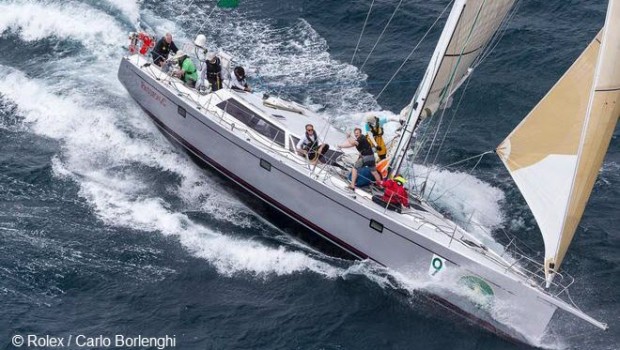


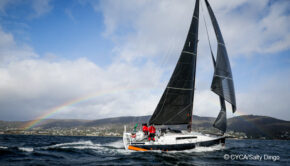
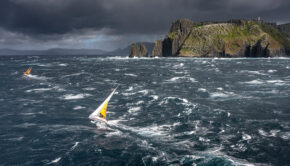
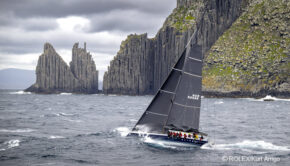
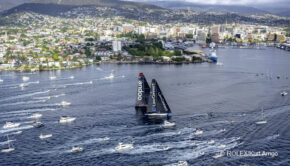
 We’ll keep your information safe.
We’ll keep your information safe.